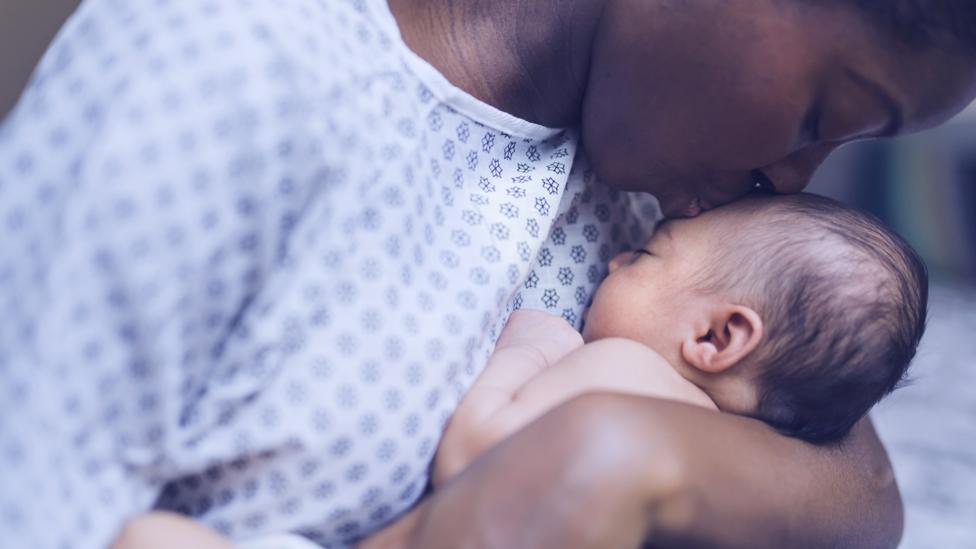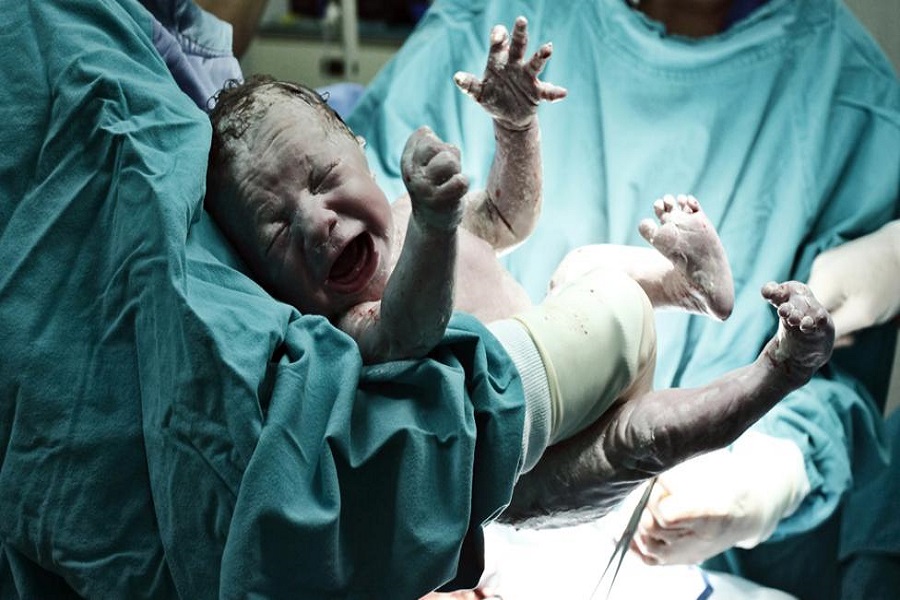Giving birth can be one of the most painful experiences in a woman’s life, yet the long-term effects that trauma can have on millions of new mothers are still largely ignored.
It’s 03:00. My pillow is soaked with cold sweat, my body tense and shaking after waking from the same nightmare that haunts me every night. I know I’m safe in bed – that’s a fact. My life is no longer at risk, but I can’t stop replaying the terrifying scene that replayed in my head as I slept, so I remain alert, listening for any sound in the dark.
This is one of the ways I experience post-traumatic stress disorder (PTSD).
PTSD is an anxiety disorder caused by very stressful, frightening or distressing events, which are often relived through flashbacks and nightmares. The condition, formerly known as “shellshock”, first came to prominence when men returned from the trenches of World War One having witnessed unimaginable horrors. More than 100 years after the guns of that conflict fell silent, PTSD is still predominantly associated with war and as something largely experienced by men.
But millions of women worldwide develop PTSD not only from fighting on a foreign battlefield – but also from struggling to give birth, as I did. And the symptoms tend to be similar for people no matter the trauma they experienced.

A traumatic delivery can be one of the causes that lead women to develop PTSD after they have given birth (Credit: Getty)
“Women with trauma may feel fear, helplessness or horror about their experience and suffer recurrent, overwhelming memories, flashbacks, thoughts and nightmares about the birth, feel distressed, anxious or panicky when exposed to things which remind them of the event, and avoid anything that reminds them of the trauma, which can include talking about it,” says Patrick O’Brien, a maternal mental health expert at University College Hospital and spokesman for the Royal College of Obstetricians and Gynaecologists in the UK.
Despite these potentially debilitating effects, postnatal PTSD was only formally recognised in the 1990s when the American Psychiatry Association changed its description of what constitutes a traumatic event. The association originally considered PTSD to be “something outside the range of usual human experience”, but then changed the definition to include an event where a person “witnessed or confronted serious physical threat or injury to themselves or others and in which the person responded with feelings of fear, helplessness or horror”.
This effectively implied that before this change, childbirth was deemed too common to be highly traumatic – despite the life-changing injuries, and sometimes deaths, women can suffer as they bring children into the world. According to the World Health Organization, 803 women die from complications related to pregnancy and childbirth every day.
Regardless of the statistics, for the women who go through these experiences, there can be a long-lasting impact on their lives
There are few official figures for how many women suffer from postnatal PTSD, and because of the continued lack of recognition of the condition in mothers, it is difficult to say how common the condition really is. Some studies that have attempted to quantify the problem estimate that 4% of births lead to the condition. One study from 2003 found that around a third of mothers who experience a “traumatic delivery”, defined as involving complications, the use of instruments to assist delivery or near death, go on to develop PTSD.
With 130 million babies born around the world every year, that means that a staggering number of women may be trying to cope with the disorder with little or no recognition.
And postnatal PTSD might not only be a problem for mothers. Some research has found evidence that fathers can suffer it too after witnessing their partner go through a traumatic birth.
Regardless of the exact numbers, for those who go through these experiences, there can be a long-lasting impact on their lives. And the symptoms manifest themselves in many different ways.
“I regularly get vivid images of the birth in my head,” says Leonnie Downes, a mother from Lancashire, UK, who developed PTSD after fearing she was going to die when she developed sepsis in labour. “I constantly feel under threat, like I’m in a heightened awareness.”
Lucy Webber, another woman who developed PTSD after giving birth to her son in 2016, says she developed obsessive behaviours and become extremely anxious. “I’m not able to let my baby out of my sight or let anyone touch him,” she says. “I have intrusive thought of bad things happening to all my loved ones.”

Nightmares that cause women to relive the fear, pain and helplessness they felt during childbirth are a common symptom of postnatal PTSD (Credit: Getty)
Not all women who have difficult births will develop postnatal PTSD. According to Elizabeth Ford of Queen Mary University of London and Susan Ayers of the University of Sussex, it has a lot to do with a woman’s perception of what they went through.
“Women who feel lack of control during birth or who have poor care and support are more at risk of developing PTSD,” the researchers write.
The stories from women who have developed PTSD after giving birth seem to reflect this.
Women who feel lack of control during birth or who have poor care and support are more at risk of developing PTSD
Stephanie, whose name has been changed to protect her identity, says she was poorly cared for during labour and midwives displayed a lack of empathy and compassion. A particularly difficult labour saw her being physically held down by staff as her son was delivered. “He was born completely blue and taken away to be resuscitated and I was given no information on his condition for hours.”
Emma Svanberg, a chartered clinical psychologist who is involved in the Make Births Better Campaign, says this is a common theme from the women she hears from.
“The factor which we hear about time and time again is lack of kindness and compassion from staff,” she says.
A study by researcher Jennifer Patterson, at Napier University in Edinburgh, suggests that while midwives are often aware that giving birth can be traumatic for women, they are often so busy they struggle to offer adequate support and information to mothers who may be at risk of PTSD.

Certain groups of women are also more likely to develop postnatal PTSD even before they give birth.
“For women who have a history of prior trauma – perhaps victims of sexual abuse in childhood, those who have previously had PTSD, or depression or anxiety – the risk of developing PTSD is significantly higher. They’re five times more likely,” says Rebecca Moore, a perinatal psychiatrist working for the NHS in East London.
Postnatal processing
The challenge of PTSD resides in the brain. Usually, memories are filed away in the brain’s hippocampus. But if an experience is traumatic, the mind goes into fight-or-flight mode and the part of the brain associated with fear, the amygdala, switches on. This causes memories to become stuck in this primitive part of the brain rather than being safely filed away.
It also means that when something reminds a mother of her experience – such as seeing birth depicted on TV or being in a hospital – the traumatic memories feel less like memories and more like the woman is still in imminent danger, triggering physical reactions like panic attacks or flashbacks.
This broken filing system means “you get a kind of looping of the memory in the mind all the time”, Moore explains.
It may cause structural changes in the brain too. Researchers at the University of California studied the brains of 89 current or former members of the military with PTSD using brain scans to measure the volume of various parts of the brain. It showed that the right amygdala in the brains of military-trained individuals with PTSD were 6% larger than their peers. The right-hand part of the amygdala is particularly associated with controlling fear and aversion to unpleasant stimuli.
“We wonder if amygdala size could be used to screen who is most at risk to develop PTSD symptoms after a mild traumatic brain injury,” says Joel Pieper of University of California, San Diego, who was one of those who led the study.

Whether similar changes occur in the brains of women with postnatal PTSD is not yet known, but it could offer a way of diagnosing those who are affected. The complex mixture of symptoms experienced by women with PTSD after birth can often lead to delays and even misdiagnosis.
Another issue standing in the way of diagnosis is the stigma attached to the condition. Some women feel uncomfortable speaking openly about it for fear of being seen as a failure as a mother, or of seeming ungrateful for their baby.
Svanberg believes birth trauma is a feminist issue. “There is a huge body of research on the disbelief of women’s pain, especially marginalised women, and often women’s voices are silenced,” she says. Many experts agree that women are simply not listened to or given the information they need to make the best decisions for themselves and their family. (Read more about how women’s pain is more likely to be dismissed than men’s).
“Giving women the facts about different modes of delivery while they are pregnant isn’t scary, it’s empowering,” adds Moore. “Women are capable of making up their own minds, but rarely are they properly informed about risks and treatment when it comes to birth.”
She believes the problem is more of a societal one. “Women are often treated like princesses when they are pregnant, but once the baby is born, it’s all about the baby,” she says. “It’s not uncommon for new mothers suffering with mental illness to hear ‘You’ve got a healthy baby, why are you complaining?’ And it’s then even more difficult for women to pluck up the courage to ask for help.”
It’s thought that half of women with perinatal mental health problems won’t be treated.
“There’s still shame in seeking help and women struggling often fear they will be judged and criticised,” says Moore.

Attempting to keep her condition hidden in this way started to harm Stephanie’s relationships with her husband and her older daughter. Her own PTSD manifested as hyper-vigilance, leaving her in a permanent and exhausting state of being alert and expecting the worst.
“I knew I wasn’t OK but kept it hidden for months,” says Stephanie. “I wasn’t eating or sleeping. I refused to let anyone look after my son. My other children relied on their dad as I was too focused on my baby.
“My relationship suffered with my daughter, who was just two. I lost all my confidence in my parenting ability when I was always calm and went with the flow before. I pushed my husband and family away.”
Nearly all women involved in the research reported initial feelings of rejection towards their baby
A study led by the University of Sussex confirmed women with postnatal PTSD reported negative effects on their relationship with their partner, including sexual dysfunction, disagreements and blame for the events surrounding the birth. The mother-baby bond was also seriously affected.
Nearly all women involved in the research reported initial feelings of rejection towards their baby and while this changed over time, the study concluded that childbirth-related PTSD can have “severe and lasting” effects on women and their relationships.
For others, it is their career that suffers.
“PTSD has changed my whole life,” says Leonnie Downes, who used to work for the North West Ambulance Service. “I had a good career, and I’ve had to leave my job to become self-employed just so I can work from home. My wife has had to leave her job too and has become my registered carer. I’m now registered disabled and for the first time ever, we now have to live off disability benefits.”

Moore says she regularly meets women who are too traumatised to return to work, including paramedics and midwives.
Lucy Webber is one such midwife. “I quit because I couldn’t cope with not being able to give women the support they need,” she explains.
But there is help available for women who are struggling with postnatal PTSD, provided they are able to access it. Treatment typically takes the form of medication or cognitive behavioural therapy (CBT) – a talking therapy designed to change the way someone thinks and behaves. Eye movement desensitisation and reprocessing (EMDR) can also be used, which sometimes involves tapping or music to help a patient’s brain remember they are in the present, not trapped in the moment of their flashback. Research also has shown that transcendental meditation can help war veterans with PTSD.
Birth trauma is not that difficult to treat, but it is very difficult for women and partners to access appropriate support – Emma Svanberg
“Birth trauma is not that difficult to treat, but it is very difficult for women and partners to access appropriate support,” Svanberg says, warning that many women are misdiagnosed as having post-natal depression (PND) – another debilitating condition that can follow the birth of a child, but one with a different set of symptoms. In the UK, it can be hard to access treatment in some areas on the NHS, while in other countries, including the US, it can be prohibitively expensive.
But many people believe that mitigation is the answer and that better training for midwives and obstetricians could prevent women developing PTSD in the first place.

“The whole system contributes to trauma,” Moore says. “Often women are being cared for by frontline staff, who are doing their job but not with much compassion, because they are burnt out.” The Make Births Better campaign focuses on offering training to medical professionals in an attempt to tackle this. Small changes that cost nothing, such as using kind language and less jargon, can make all the difference in stopping women developing physical and mental problems as a result of giving birth.
Most women would agree that giving birth is a defining and transformative event. And with the right support, good can even come from the most traumatic of births.
Lucy Webber says her experience has helped her become a gentler parent and Stephanie has even decided to become a midwife.
Almost two years on, my own life is gradually getting easier, but I approach my daughter’s birthday with a mixture of excitement and trepidation because of the memories and physical reactions it will undoubtedly trigger. She is the best gift I could ever hope for and her birthday will also be a celebration of how far we have come since her arrival.
Besides the little toy guitar we will be giving her, perhaps the best gift I can offer is to play my own small part in challenging the norms of what it is to give birth and be a mother, so birth trauma and postnatal PTSD can be dealt with in the open.
Source: bbc Future

